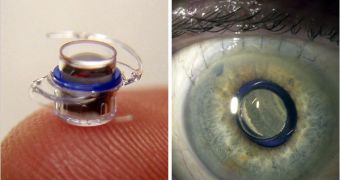People who have a very poor sight and are unable to detect details at even close ranges could soon benefit from a new implant, able to restore at least some of their sight. The pea-sized implant is destined specifically for individuals with a certain form of macular degeneration, in which the retina is severely affected. The patients who were implanted with the technology have been able to read books, watch TV, and make out the faces of the loved ones with little effort afterwards.
Experts behind the tiny telescope say that it is implanted instead of the natural lens of the eye, and that it extends the image coming through so that the light falls not only at the center of the retina – which in macular degeneration is heavily affected and unable to process the data –, but on healthy tissue around the affected areas as well. This ensures that at least a fraction of the light entering the eye actually gets processed in the visual cortex, and this amount is far larger than without the telescope, using only the eye's original lens.
The implant is made by Saratoga, California-based VisionCare Ophthalmic Technologies. The company received this March an unanimous approval from the US Food and Drug Administration (FDA), so as to pursue the development and implementation of the new prosthetic device, VisionCare Chief Executive Allen W. Hill said, quoted by The New York Times. “People can use it to recognize faces in a social setting. That’s a huge advance,” FDA advisory panel member Janet P. Szlyk added. She is also the executive director of the social services agency Chicago Lighthouse for People Who Are Blind or Visually Impaired.
The telescope only gets mounted on a single eye, which means that the patients will see a larger image on one eye, and a regular-sized one on the other. Therefore, extensive therapy and counseling is needed after the implant is fixed, so as to ensure a smooth transition and accommodation to the new abilities. The second eye is left without implant, so as to allow the patient some peripheral vision. The augmented one is for resolving details, small letters and traits on a human face. Once the patients learn to master the differences between the images they get from their eyes, they shouldn't have a problem using the prosthetic device.

 14 DAY TRIAL //
14 DAY TRIAL //